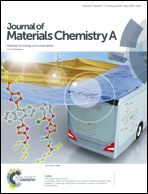Triptycene-based quinone molecules showing multi-electron redox reactions for large capacity and high energy organic cathode materials in Li-ion batteries†
Abstract
Organic redox-active molecules have attracted great attention for next generation electrode materials due to their promising advantages of low cost, natural abundance, environmental friendliness, and structural diversity. Here we propose a new molecular design strategy to achieve both large specific capacity and high energy organic cathode materials for Li-ion batteries using a triptycene scaffold as a minimal linker between the redox-active units. The triptycene molecule bearing three benzoquinone (BQ) units in a rigid tripod structure exhibits five-electron redox reactions that practically provide a specific capacity as high as 387 mA h g−1 in Li-ion coin cells. By combining electrochemical analyses with theoretical DFT calculations, we figure out that the 3-D arrangements of BQ units in triptycene not only facilitate a highly reversible access to a large number of redox states but also raise the redox potential. Due to the large capacity and the increased redox potential, the triptycene electrode can deliver a specific energy up to 1032 W h kg−1 at 0.1C-rate, which is close to two times the specific energy of the conventional inorganic cathode materials. It is also demonstrated that the cycling performance of triptycenes can be greatly improved by fabricating nanocomposite materials with the ordered mesoporous carbon CMK3.



 Please wait while we load your content...
Please wait while we load your content...